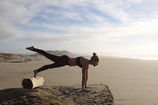
Yoga Ayurveda Love
with Dayna Holli
Yoga Instructor | Ayurvedic Practitioner | Panchakarma Technician
Marlinworks Building - Eagle 85 Willow Street 2nd Floor New Haven, CT 06511
Discover tools for mind-body-spirit wellness to live the ultimate life, one of consciousness, joyfulness and a deep connection to all living beings on this planet earth and beyond.
Offerings
+Private yoga session $85/60 mins.
+Private meditation session $40/30 mins.
+Private pranayama session $40/30 mins.
+Group yoga sessions
+Office yoga at your business
+Corporate & private wellness workshops on yoga or Ayurveda
Experience Private Yoga
Yoga is for all beings! A personal practice is best created with guidance. I love guiding students along their yoga journey. It is important for us to discuss your goals and any present needs to make the best plan for your health and wellness. I have experience working with all ages and levels and enjoy teaching those who are beginners and/or going through physical therapy or rehabilitation. Yoga is healing both to the mind, physical body and on spiritual and soul level creates a sense freedom, peace, clarity and fulfillment. Each yoga session is designed progressively and specifically for your Ayurvedic energies or doshas, abilities and needs. If you are interested in private yoga we will discuss your needs and set up our first class to see if it is a good fit. Moving forward, I set up private classes for clients either once per week or twice per week on a fixed schedule.
What to expect with a private yoga session?
+A guided vedic meditation
+Pranayama or special breathing exercises
+Warm up movements and streching
+Asana or postural practice
+Surya namaskar or tailored sun salutations
With private yoga instruction we first begin with the practice of meditation and pranayama. I will teach you specific breathing practices for relaxation and calming the central nervous system and guide you in a supportive, vedic meditation. Many people need central nervous system balancing and everyone benefits from deeper breathing. With improved, conscious breathing you will start to feel more balanced. Other stimulating breathing exercises might be appropriate for you too. It is important to understand WHY you do a certain breathing practice and how it creates shifts within your body and mind. Asana or postural practice will begin with the introduction of easy, restorative positions that are beneficial for you to have in your daily practice in the morning or evening. Then we will move into strengthening and toning asanas, standing poses and specific asanas to balance your areas of need.
What is yoga?
In Sanskrit, yoga is union. With union there can be 2 or more energies that form a bond, which creates ONE. In ancient times the practice of yoga was created and experienced in stages and the ultimate stage is that of moksha, liberation, enlightenment or samadhi. During samadhi the practitioner experiences (if she/he is still in the physical body) a radiant energy within, compassion, love and oneness with all beings.
Sage Patanjali listed the 8 stages of yoga as:
1. Yamas: self-discipline practices ahimsa (non-violence or non-harming), satya (truthfulness), asteya (non-stealing), bramacharya (sexual restraint), and aparigraha (non-possessiveness).
2. Niyamas: positive self-practices saucha (purity), santosha (contentment), tapas (discipline), svadhyaya (spiritual studies), and Ishvara Pranidhana (regular devotion to God).
3. Asana: postural practice
4. Pranayama: controlled breathwork
5. Pratyahara: reducing sesory impressions and experiences
6. Dharana: a deep mental focus on one thing, vision, object, mantra
7. Dhyana: true state of pure meditation for a period of time
8. Samadhi: balance/moksha/oneness
What is meditation?
Meditation is the act of taking time to sit down and be still for a period of time. Like Sage Patanjali’s 8 limbs of yoga, there are stages that can be observed in the practice of meditation. For beginners I suggest to find a space where you can sit in your home or outside for 5-10 minutes without interruption. Find a park bench, a place next to the ocean, the corner of a room or even a small closet or the bathroom if you require privacy and set up a chair, a cushion or pillow or a few blankets so that you are comfortable to be in a seated position for the time you have to practice. Once you sit, unwind your body by rolling the shoulders, doing a few neck circles and taking some deep breaths. Then, sit still keeping a good posture and rest your hands in your lap in a way that feels good. Practice first conscious breathing by watching your inhale and exhale and then spend the next 5-10 minutes OBSERVING what happens. You may feel a range of emotions, or experience a range of thoughts or comfort then discomfort. This is normal and with continued practice these things subside and your journey continues.
Benefits of meditation: peace, happiness, joy, relaxation, reduced fear, reduced anxiety, reduced anger, better sleep, improved clarity of thinking and memory, moment to moment living, inner freedom, wealth, love, integrity!
What is pranayama?
Prana = the inhale or life force energy Yama = control
Pranayama is a controlled breathing practice that is supportive to your physical body and mind. There are many types of pranayama exercises, some are cooling, heating, calming, stimulating, relaxing. Some improve your ability to take in more air or oxygen and some work to build abdominal health and massage the internal organs. According to Ayurveda there are specific pranayama exercises to balance certain energies or doshas.
Benefits of pranayama: balanced central nervous system, deeper breathing, peace, mental relaxation, improved lung health, improved heart health, calmer mind, freedom, enjoyment of stillness, positive energy.
What is surya namaskar?
Surya = sun namaskar = a gratitude and acknowledgement
Traditionally practiced upon rising as a morning yoga sequence, one gives thanks to the sun for it’s powerful and radiant energy and consistent heat source that supports life on our planet. When we practice with this intention, it sets the positive outlook for the day. A sun salutation or 'surya namaskar' practice is a flow of postures or asanas that connect with each other in what is called a vinyasa or flow. It’s stimulating and increases the heart rate, acting as a good cardiovascular practice. Surya namaskar is practiced so that with each action or movement a breath will match, either an inhale or exhale. When we match our breathing to a particular movement and that becomes a rhythm it supports our body’s inherent need to breath regularly and keeps the oxygen flowing. When we receive the breath of prana and give the breath of udana, wind energy or vata energy balances. There are 3 traditional types of surya namaskar: A, B & C. In my own practice I’ve created various surya namaskar sequences to help support the opening and stretching of certain parts of the body. I tailor all sun salutations to my clients so that they are approachable.














